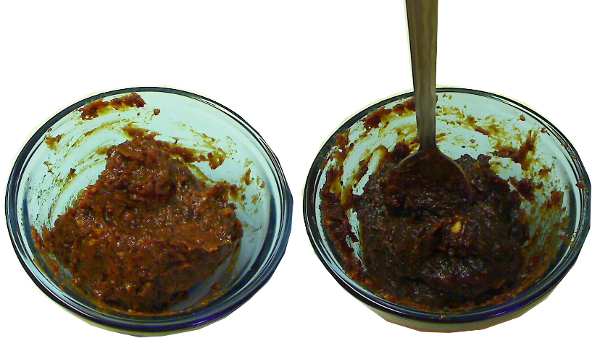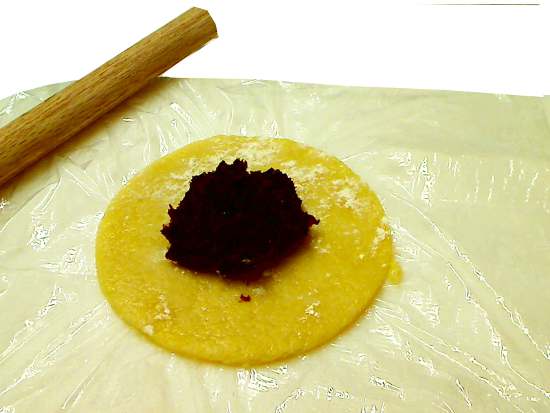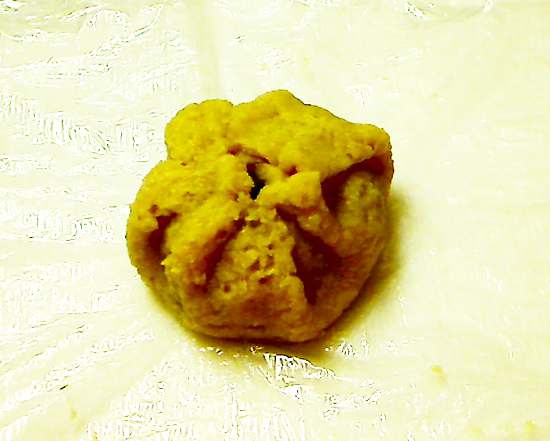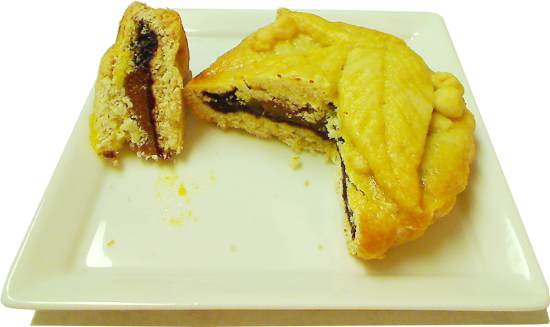
[ Equipment: oven or slow cooker. For more information about the terminology in this recipe, see Low Temperature Baking: A Journey of 3 Paths ].
The Chinese Moon Festival happens on September 22 this year, which means: it time for eating mooncakes! This recipe is a healthier take on the classic pastry. It begins with a filling made from dried plums and baby lima beans, replacing the traditional red bean paste which was loaded with fat and sugar. The shell is a low-fat, soft crumb version of the crispy, eggy crust of Shanghai mooncakes from Malaysia. All together, this tasty reconstruction has 1/3 the calories of the mooncakes of yore.
Many people prefer to buy mooncakes than make them under the mistaken belief that they require fancy molds and esoteric ingredients. The popular thin-skinned Cantonese mooncakes sold in the US are molded, but other styles, like the Shanghai mooncakes, are shaped by hand with varying degrees of decoration. Homemade mooncakes can be as elaborate as the baker has time to lavish on them, pleasing the eyes and palette - and the wallet, since a single mooncake can cost over $10 US, and prices are rumored to be higher this year.
This recipe doesn't jettison the original concept of mooncakes, as some of today's so-called mooncakes might be accused of doing. In the ingredients and the form are elements of the past. Although the basis of the filling is pureed dried plums, the baby lima beans give structure, cut the intense sweetness and echo the legume nature and shading of traditional red bean paste. (Prepare the beans by soaking them in water ovenight; then simmer until tender, about 40 to 50 minutes.) The 1/2 to 1 teaspoon of sugar is to taste. It acts as a preservative too, since the lima beans dilute the sugar concentration and could weaken the anti-bacterial properties inherent in the dried fruit.
The rich brown of the plum-bean paste contrasts nicely with the yellow-orange of the whole dried apricot, representing the moon (and standing in for the traditional salted egg yolk). Alternatives to dried plums include dried figs or dates. The lima beans could be replaced with another firm, mild flavor bean like mung beans or soy beans or try any bean in the cupboard. Dried nectarines, peaches or kumquats would make fine moons too, if they are small and fit inside the pastry.
I first read about Shanghai mooncakes at Corner Cafe. They originated in Malaysia, not Shanghai, by way of a similar pastry from Hong Kong. For my recipe, the biscuit crust has been modified in content and technique to reduce the fat and develop a flakier crumb. Yogurt compensates for the excised butter. It imparts richness as well as hydrates the dough. I originally substituted more beaten egg, but decided that the strong eggy flavor competed with the filling. Plain yogurt is fine, but vanilla yogurt brings a touch of smoothness.
Shanghai mooncakes have a crispy, crunchy shell, while the skin on Cantonese mooncakes is soft and chewy. In both types, the dough is kneaded to develop the gluten. In this recipe, the wet ingredients are incorporated into the dough with very little kneading or stirring to avoid developing the gluten for a tender, flaky pastry, as in a pie crust. In the alternative, for a more traditional, chewier texture, the dough could be kneaded briefly. I pressed the mooncakes into mini tart pans to flatten them into disks and flute the edges, like the scalloped sides on Cantonese mooncakes.
The decoration on top of Shanghai mooncakes can be as simple as almond slivers or pumpkin seeds arranged in an attractive pattern. However, consumers have come to associate the fine and fancy reliefs on Cantonese cakes as a measure of quality. While hand-crafted individual designs are too labor intensive for commercial sales, artisan and home bakers can let their imaginations fly. For the cakes the pictures, I cut out designs from scrap dough, embossed them with the dull back of the knife, laid the pieces out on top and varnished the surface with egg wash to glue them down. An alternative to cutting out and assembling the designs is to imprint the scrap dough with a small cookie mold or stamp it with a cookie stamp.
Makes 2 mooncakes
- 310 calories per mooncake
- Oven Temperature: 250°F/121°C
Pastry:
- 1 tablespoon butter or vegetable shortening
- 1/8 cup sugar
- 1/4 teaspoon baking powder
- 1/2 cup flour
- pinch of salt
- 1 tablespoon plain or vanilla yogurt (see text)
- 1 egg beaten (see text)
- 12 dried plums or prunes (about 1/2 cup)
- 1/8 cup cooked baby lima beans (see text)
- 1/2 to 1 teaspoon sugar
- 2 dried apricots (see text)
Filling Method (makes about 3 tablespoons):

1. Put dried plums, lima beans and sugar in a small bowl and with an immersion blender, puree to a smooth paste. Alternatively, put ingredients in mini food processor and puree to a smooth paste.

2. Transfer paste to a microwave-safe dish and heat on HIGH for 15 to 20 seconds. Remove (careful, dish may be very hot) and stir paste vigorously for about 30 seconds to release steam and cool. Put back in the microwave and repeat heat-stir process another 5 or 6 times, until mixture has darkened and stiffened to the point that an inserted spoon will remain standing.
Alternatively, transfer paste to a small nonstick fry pan and stir over low heat until mixture has darkened and stiffened to the point that an inserted spoon will remain standing.

3. Cool and store in a closed container or plastic bag. Refrigerate until ready to assemble mooncakes.
Pastry Method:
Pre-heat oven or cooker to 250°F/121°C.

1. In a bowl, cream butter and sugar with fork until well combined.

2. In a small bowl, mix flour, baking powder and salt until well combined. Cut flour mixture into butter mixture with a fork or pastry blender until mixture looks uniformly crumbly.

3. Add yogurt and gently toss in flour until yogurt is evenly distributed.

4. Add beaten egg, one teaspoon at a time, using toss, press, crumble actions until mixture just comes together and forms a dough (about 3 to 5 teaspoons). Avoid stirring or kneading the dough or the gluten will toughen the pastry (or lightly knead for a chewier texture - see discussion above).

5. Divide dough into 2 portions.

6. Shape each portion into a small disk and cover with plastic wrap (plastic wrap should be larger than 6-inches square). Refrigerate for 30 minutes.

7. Unwrap one disk, lightly dust the dough and plastic with flour, and place disk on center of plastic wrap. Place a another piece of plastic wrap over the dough and roll out a rough circle about 5-1/2 to 6 inches.

8. Remove top plastic wrap, dust with flour and press a 4-1/2 inch round cookie or biscuit cutter into dough. Peel off excess dough and save for decoration. The 4-1/2 inch dough circle could be cut out freehand with a knife too. The cookie cutter method is only a convenience.

9. Optional: place a dried apricot in the center of dough.

10. Put 1-1/2 tablespoons of filling in center of dough, covering the apricot.

11. Lift up sides of dough to wrap the filling and pinch the top closed to form a ball. If the dough is very moist and threatens to tear, slide a butter knife or a frosting spatula under the dough and gently lift up over the filling.

12. Dust the dough ball with flour and gently flatten into a disk, about 3-inches in diameter. Put the disk into a greased mini-tart pan (4-inches diameter), seam side down.

13. Press disk outward until the disk touches the sides of the pan. If there are any thin spots on the surface, cover them with thin sections of scrap dough and rub down edges. The patches don't have to be blended into the surface, because any telltale seams will be hidden by decoration.

14. With scrap dough, create a decoration on top of the mooncake. Typical mooncake images include flowers, leaves, animals, fishes, abstract patterns and chinese characters. Brush the mooncake with an egg wash made from the leftover beaten egg thinned with 1 or 2 teaspoons of water. In the above picture, the flowerhead on the daisy decoration was covered with poppy seeds for a 3-dimensional effect. The poppy seeds were sprinkled on after the egg wash so they would adhere to the surface.

15. Bake at 250°F/121°C for 60-70 minutes until golden brown. Cool for 30 minutes and unmold. Put the mooncakes on a rack and continue cooling until the bottoms of the mooncakes are dry.

16. The picture above shows the inside of a mooncake with apricot "moon". I've stored these mooncakes at room temperature for over a week. The high sugar, low moisture filling resists spoilage. However, I strongly recommend that they be stored in the refrigerator in an airtight plastic bag or container for maximum freshness.
Shown below are some more of my mooncake creations. The designs are (in order) a Chinese dragon, leaves and berries and the Chinese character for "moon".




No comments:
Post a Comment